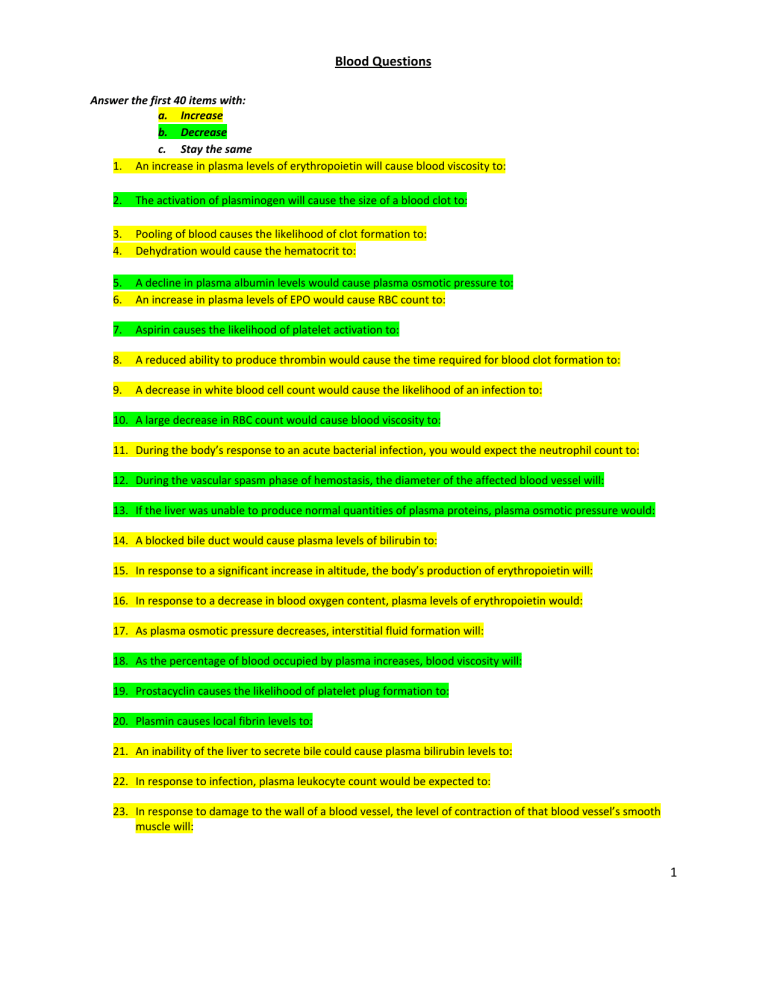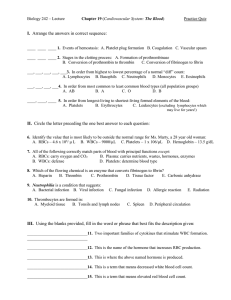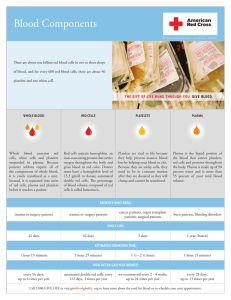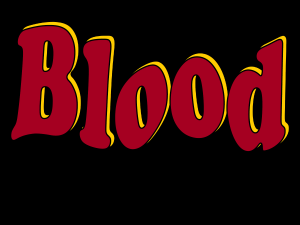Blood Physiology Worksheet: Viscosity, Clotting, Cell Counts
advertisement

Blood Questions Answer the first 40 items with: a. Increase b. Decrease c. Stay the same 1. An increase in plasma levels of erythropoietin will cause blood viscosity to: 2. The activation of plasminogen will cause the size of a blood clot to: 3. 4. Pooling of blood causes the likelihood of clot formation to: Dehydration would cause the hematocrit to: 5. 6. A decline in plasma albumin levels would cause plasma osmotic pressure to: An increase in plasma levels of EPO would cause RBC count to: 7. Aspirin causes the likelihood of platelet activation to: 8. A reduced ability to produce thrombin would cause the time required for blood clot formation to: 9. A decrease in white blood cell count would cause the likelihood of an infection to: 10. A large decrease in RBC count would cause blood viscosity to: 11. During the body’s response to an acute bacterial infection, you would expect the neutrophil count to: 12. During the vascular spasm phase of hemostasis, the diameter of the affected blood vessel will: 13. If the liver was unable to produce normal quantities of plasma proteins, plasma osmotic pressure would: 14. A blocked bile duct would cause plasma levels of bilirubin to: 15. In response to a significant increase in altitude, the body’s production of erythropoietin will: 16. In response to a decrease in blood oxygen content, plasma levels of erythropoietin would: 17. As plasma osmotic pressure decreases, interstitial fluid formation will: 18. As the percentage of blood occupied by plasma increases, blood viscosity will: 19. Prostacyclin causes the likelihood of platelet plug formation to: 20. Plasmin causes local fibrin levels to: 21. An inability of the liver to secrete bile could cause plasma bilirubin levels to: 22. In response to infection, plasma leukocyte count would be expected to: 23. In response to damage to the wall of a blood vessel, the level of contraction of that blood vessel’s smooth muscle will: 1 Blood Questions 24. Urokinase is an enzyme that activates plasminogen. Thus, urokinase causes the likelihood of clot formation to: 25. As body temperature increases, the amount of blood flowing to capillaries in the skin will: 26. As erythropoiesis continues, the number of organelles in a developing RBC will: 27. A mismatched transfusion of Type AB blood into an individual with Type O blood would make plasma [bilirubin]: 28. During an infection the size of the buffy coat will: 29. Daily injections of erythropoietin will make the percentage of blood occupied by plasma: 30. During a severe allergic reaction, the number of eosinophils in the body would: 31. As plasma [thrombin] increases, plasma [fibrinogen] will: 32. If plasmin was activated prior to clot formation, the time it takes for clot formation to occur would: 33. During leukopenia the body’s ability to prevent bacterial infection will: 34. As the rate of red blood cell destruction increases, plasma [bilirubin] will: 35. As erythropoietin secretion from the kidneys decreases, hematocrit will: 36. As the percentage of whole blood occupied by plasma decreases, blood viscosity will: 37. A decrease in intrinsic factor production would cause the blood’s oxygen carrying capacity to: 38. Infection with a parasitic fluke would cause the number of granulocytes in the body to: 39. As liver function decreases, the ability of the body to form fibrin would most likely: 40. Large doses of antibiotics would cause the ability of the body to form thrombin to: Items 41­116 are multiple choice. 41. Which of the following is NOT correctly matched with its function? a. Albumin – maintains plasma osmotic pressure b. Transferrin – transports heme within the plasma c. Hemoglobin – transports oxygen d. Thrombin – involved in fibrin production e. Ferritin – storage of iron in the liver 42. Which of the following would be the greatest source of blood viscosity? 2 Blood Questions a. b. c. d. e. Basophils Erythrocytes Reticulocytes Thrombocytes Lymphocytes 43. Which of the following occurs in the red bone marrow? a. Erythropoiesis b. Leukopoiesis c. Thrombopoiesis d. All of the above e. Only 2 of the above 49. a. b. c. d. e. Which of the following contains granules filled with histamine and heparin? Erythrocyte Basophil Eosinophil Thrombocyte None of the above a. b. c. d. e. The smallest formed element is the: RBC Lymphocyte Macrophage Platelet Hemocytoblast a. b. c. d. e. Which of the following is the LARGEST? Number of nuclei in a red blood cell. Normal percentage of WBCs in the blood that are neutrophils Number of iron atoms in one hemoglobin protein. Number of pulmonary veins that empty into the left atrium. Normal temperature of blood in degrees Fahrenheit. 50. 51. 52. If an individual’s intact endothelial cells were unable to secrete prostacyclin, his platelet plugs would most likely be: a. Larger than normal b. Smaller than normal c. Still normal d. Composed primarily of leukocytes e. Both C and D are correct 55. a. b. c. d. e. In a condition known as disseminated intravascular coagulation, bacterial toxins activate thrombin. This would most likely cause: Production of prothrombin activator Conversion of thrombin to prothrombin Production of fibrin Production of a platelet plug All of the above 3 Blood Questions 56. a. b. c. d. Which of the following would cause a rise in plasma bilirubin levels? Inability to secrete bile Excessive destruction of white blood cells The presence of vitamin K producing bacteria in the colon Deficiency of EPO 58. A deficiency in _________ could cause clotting problems, while a deficiency in ________ could cause anemia. a. Iron: Cobalt b. Calcium: Ferrenium c. Copper: Manganese d. Sodium: Iron e. Calcium: Iron 59. Which of the following is characteristic of plasma? a. 5 times as viscous as H O 2 b. Scarlet to dark red in color c. Volume of 5­6L in males d. 90% water e. All of the above 60. Which of the following is a function of blood? i. Gas transport ii. Hormone transport iii. Heat transport a. b. c. d. e. i only ii only iii only ii and iii only i, ii, and iii 61. The movement of white blood cells towards a chemical known as LPS would be an example of ________________________. a. Diapedesis b. Positive chemotaxis c. Amoebeosis d. Amphoteris 62. Which of the following WBCs contains granules filled with chemicals involved in the inflammatory process? a. Basophils b. Lymphocytes c. Platelets d. Neutrophils e. Eosinophils 63. _______ is produced quickly by the _______ clotting mechanism and slowly by the __________ clotting mechanism. 4 Blood Questions a. b. c. d. e. Prothrombin activator – extrinsic – intrinsic Prothrombin activator – intrinsic – extrinsic Thrombin – extrinsic – intrinsic Thrombin – intrinsic – extrinsic Plasmin – intrinsic – extrinsic 64. Which of the following events associated with coagulation occurs LAST? a. Clot retraction b. Fibrinolysis c. Formation of fibrin d. Formation of prothrombin activator e. Formation of thrombin 65. Which of the following leukocytes exerts the most control over the immune system? a. Neutrophils b. Basophils c. Granulocytes d. Lymphocytes e. Monocytes 66. Which of the following is NOT a site of erythropoiesis in the adult male? a. Liver b. Proximal epiphysis of the humerus c. Sternum d. Ribs e. Proximal epiphysis of the femur 67. Which of the following shuttles iron to the liver? a. Albumin b. Stercobilin c. Transferrin d. Ferritin e. Hemosiderin 68. Which of the following is a function of blood? a. Nutrient transport b. Heat transport c. Maintaining body temperature d. Immunity e. All of the above 69. Art VanDelay has a blood volume of 5 L. 59% of his blood is composed of RBCs. 1% of his blood is composed of WBCs and platelets. How many liters of water does his blood contain? a. 1 L 5 Blood Questions b. c. d. e. 1.8 L 2L 2.4 L 2.7 L 70. Bilirubin is formed from: a. Heme b. Globin c. Transferrin d. Gastroferritin e. Factor X 71. Which of the following is INCORRECT ? a. In a female adult, aged red blood cells are destroyed in the spleen b. In a female adult, red blood cells are primarily synthesized in the tibia and fibula c. In a male child, red blood cells function in oxygen transport d. Red blood cells that lack hemoglobin are less efficient at O transport 2 e. Red blood cells lack nuclei 72. In the liver, iron can be stored as: a. Hemosiderin . b. Bilirubin. c. Stercobilin. d. Transferrin. e. Albumin 73. Which of the following is TRUE ? a. Blood is an example of a specialized epithelial tissue b. Neutrophils and eosinophils are not formed elements c. Water is 3 times as viscous as blood d. Blood temperature is typically 18°C lower than core body temperature e. Normal blood pH is basic 74. Blood is involved in: I. II. III. IV. a. b. c. d. e. Nutrient distribution Transport of nitrogenous wastes Maintaining adequate electrolytes levels in the body Transport of white blood cells I, II, III, and IV I, II, and III II, III. and IV I, II, and IV I, III, and IV 75. Red blood cells: a. Are about 7.5mm in diameter and biconcave b. Function primarily in maintenance of interstitial fluid osmotic pressure 6 Blood Questions c. d. e. Contain more organelles than the normal muscle cell Function in oxygen and carbon dioxide transport All of the above 76. Which of the following is TRUE ? a. Oxyhemoglobin is more likely to be found in the superior vena cava than in the aorta b. Deoxyhemoglobin is more likely to be found in the aorta than in the superior vena cava c. Each molecule of hemoglobin can transport 1 molecule of oxygen d. The binding of hemoglobin to oxygen is reversible e. More than 1 of the above 77. Erythropoiesis: a. Occurs in the yellow bone marrow b. Is primarily stimulated by the hormone thrombopoietin c. Involves cells known as hemocytoblasts d. Is always stimulated when blood oxygen content is increased e. None of the above 78. Leukocytes: a. Are also known as lymphocytes and function in immunity b. Are capable of moving toward chemicals released by pathogens c. Are normally found in blood at a count of 5,000­10,000 per 10mL of blood d. Are formed in the red bone marrow from stem cells known as erythroblasts e. Are primarily found within the bloodstream and rarely found in connective tissue 79. Monocytes and basophils: a. Are both granulocytes b. Are both agranulocytes c. Are the 2 least common WBCs in the blood d. Are both capable of diapedesis e. None of the above 80. Platelet plug formation: a. Is primarily a negative feedback process b. Usually occurs after fibrinolysis c. Is restricted to the site of injury by prostacyclin released by intact cells d. Provides a permanent repair to a tear in a blood vessel wall e. None of the above 81. Blood: a. b. c. d. e. Is classified as a combination of epithelial and connective tissues Has an average pH of 7.4, making it very acidic Is 90% water Has an average temperature of 87.6°F None of the above is correct. 82. Put the following steps of coagulation in the correct order. 1. Fibrinolysis 2. Prothrombin activator is formed 7 Blood Questions 3. 4. 5. a. b. c. d. e. Subendothelial collagen is exposed Thrombin is formed from prothrombin Fibrinogen is converted to fibrin 1­3­4­2­5 3­1­4­2­5 3­2­4­5­1 3­4­2­5­1 3­2­4­1­5 83. Which of the following can retard coagulation? I. Low platelet count II. Aspirin III. Liver disease IV. Lack of dietary or enteric vitamin K a. b. c. d. e. I, II, III, and IV I, II, and III I, II, and IV II, III, and IV I only 84. Which of the following is TRUE ? a. Platelets are also referred to as thrombocytes and are primarily synthesized in the liver. b. Platelets are fragments of cells known as megakaryocytes and they persist in the circulation for 10­12 days. c. A differential WBC count determines the % of blood occupied by leukocytes, erythrocytes, and platelets. d. Leukopenia, an abnormally high WBC count, is often caused by anticancer drugs. e. Lymphocytes never survive in the body for more than 30­60 minutes. 85. Which of the following is NOT a function of blood? a. Carbon dioxide transport b. Maintaining electrolyte balance in the body c. Heat production d. Transport of immune proteins e. Hormone transport 86. Hemoglobin: a. Transports oxygen but not carbon dioxide b. Is contained within the nucleus of the mature RBC c. Contains no metals d. Can bind both oxygen and carbon monoxide e. 2 of the above are true 87. A typical RBC: a. Lives for 120 days and then divides to yield 2 new RBCs b. Could eventually be engulfed by a macrophage in the spleen 8 Blood Questions c. d. e. Lacks organelles but contains a polymorphic nucleus Has a spherical shape, which helps minimize available surface area More than one of the above is correct 88. Which of the following is TRUE of leukocytes? a. They account for 9­10% of total plasma volume b. They are not all produced in the red bone marrow c. They are capable of diapedesis, which is the process by which they leave the bloodstream d. All of the above e. 2 of the above 89. Which WBC is NOT correctly matched with its function? a. Eosinophils → destroy parasitic worms b. Basophils → leave the bloodstream and become macrophages c. T lymphocytes → attack virus­infected cells d. Neutrophils → involved in bacterial infections e. None of the above 90. Which of the following is TRUE ? a. Neutrophils are referred to as polymorphonuclear leukocytes. b. All monocytes within the bloodstream are referred to as macrophages. c. Normally there are less than one thousand lymphocytes in the body. d. When stained with Wright’s stain, eosinophils contain characteristic dark purple granules. e. All of the above 91. The shape of a red blood cell can best be described as _____________. One advantage of that shape is that _______________________. a. Biconcave: it makes the red blood cell more flexible. b. Spherical: it allows the red blood cell to maximize its organelle content. c. Biconcave: it compresses the red blood cell’s nucleus to allow for more frequent DNA transcription. d. Stellate: it increases the red blood cell’s surface area. e. None of the above are correct 92. Suppose a red blood cell contains 1 million molecules of hemoglobin. How many molecules of iron does it contain? a. 250,000 b. 1 million c. 4 million d. 10 million e. 1 billion 93. All of the following are PRODUCTS of RBC recycling/disposal EXCEPT: a. Iron b. Amino acids c. Bilirubin 9 Blood Questions d. e. Transferrin A and B 94. All of the following are plasma proteins EXCEPT: a. Albumin b. Prothrombin c. Fibrinogen d. Antibodies e. All of the above ARE plasma proteins. 95. Which of the following is the 5th most abundant FORMED ELEMENT in the blood? a. Eosinophils b. Lymphocytes c. Monocytes d. Platelets e. Neutrophils 96. What metal ion is essential to virtually all stages of coagulation? a. Sodium b. Cadmium c. Calcium d. Strontium e. Potassium 97. All of the following would be considered normal pH values for blood EXCEPT: a. 7.35 b. 7.44 c. 7.86 d. 7.02 e. 2 of the above 98. Which of the following is NOT TRUE? a. Platelet plug formation is a positive feedback process. b. An increase in plasma levels of thrombin will cause an increase in plasma levels of fibrin. c. Prostacyclin acts to inhibit platelet plug formation. d. Fibrinogen is primarily produced by the kidneys e. All of the above 99. Which of the following is NOT TRUE? a. The most abundant variety of circulating white blood cells are the lymphocytes. b. Bilirubin is transported to the liver by albumin. c. Iron is transported to the liver by transferrin. d. Each hemoglobin contains 4 heme groups e. 2 of the above 100.Plasma cells and macrophages are ultimately derived from: a. Lymphocytes b. B lymphocytes c. Macrophages 10 Blood Questions d. e. Hemocytoblasts None of the above 101.Which of the following indicates the relative number of formed elements in a microliter of blood? a. RBCs > WBCs > Platelets b. RBCs > Platelets > WBCs c. WBCs > Platelets > RBCs d. Platelets > RBCs > WBCs e. None of the above are correct 102.Which of the following is TRUE of blood? a. Blood pH is usually between 7.75 and 7.85. b. The human body contains a total of 4­6 milliliters of blood. c. Blood is a specialized type of epithelial tissue. d. Blood consists of formed elements and plasma. e. Blood is about 5 times less viscous than water. 103.The majority of red blood cell destruction occurs in the: a. Liver b. Kidney c. Pancreas d. Spleen e. Bile ducts 104.A single molecule of hemoglobin can transport up to ___ molecules of oxygen. a. 1 b. 2 c. 4 d. 8 e. 12 105.Which of the following components of plasma functions by preventing pH change? a. Electrolytes such as K+ b. Nutrients such as glucose c. Wastes such as lactic acid d. Buffers such as bicarbonate e. Water 106.All of the following are TRUE of red blood cells EXCEPT: a. They do not contain a nucleus. b. They are shaped like a biconcave disk. c. They contain hemoglobin d. They function primarily in transport of CO . 2 e. They are formed in the red bone marrow. 107.Which of the following is TRUE? a. Basophils and lymphocytes are both granulocytes b. Neutrophils and monocytes are both agranulocytes c. All leukocytes are granulocytes 11 Blood Questions d. e. All agranulocytes are leukocytes None of the above 108.Globulins produced by plasma cells function as __________, while albumin is important for __________. a. Clotting factors; osmotic pressure b. Antibodies; oxygen transport c. Antibodies; osmotic pressure d. Clotting factors; heat transport e. Leukocytes; clotting 109.During hemoglobin recycling, iron is transported to the liver by ___________ and stored there as ____________. a. Transferrin – ferritin b. Ferritin ­ transferrin c. Albumin – transferrin d. Transferrin – albumin e. Basophils – hemoglobin 110.Prostacyclin is released by ____________ cells lining a blood vessel and it functions by __________ platelets. a. Healthy – repelling b. Damaged – repelling c. Healthy – attracting d. Damaged – attracting e. Damaged – destroying 111.During the vascular spasm phase of hemostasis, the __________ muscle in the wall of the damaged blood vessel will __________. This causes blood vessel diameter to _________. a. Skeletal – contract – increase b. Skeletal – relax – decrease c. Smooth – contract – decrease d. Smooth – relax – increase e. Smooth – contract – increase 112.Which of the following is the only true nucleated cell? a. Erythrocyte b. Red blood cell c. Basophil d. Platelet e. Thrombocyte 113.All of the following are TRUE EXCEPT: a. Platelets contain actin and myosin, which help during clot retraction. b. Plasmin is the chemical responsible for fibrinolysis. c. More prothrombin activator is made via the intrinsic path than via the extrinsic path. d. Calcium plays a role in blood clot formation. 12 Blood Questions e. Leukopoiesis occurs primarily in the white bone marrow. 114.Which of the following organs produces most of the plasma proteins? a. Spleen b. Liver c. Kidney d. Red bone marrow e. White bone marrow 115.Which of the following is most necessary for coagulation? a. Vitamin A b. Vitamin D c. Vitamin E d. Vitamin K e. Vitamin Z 116.Which of the following literally means “clot?” a. Erythro b. Thrombo c. Cyte d. Leuko e. Hemo The remaining items are short/medium answer questions. 1. 2. 3. 4. 5. Describe the shape and contents of a red blood cell. Explain the functional significance of the shape and contents. See your instructor Name the 3 processes of hemostasis. For each process explain what it is and why it matters in one sentence. Be concise. See your instructor Cancer patients being treated with chemotherapeutic drugs to destroy rapidly dividing cells are monitored closely for changes in their red and white blood counts. Why? See your instructor A middle­aged college professor from Maryland is in the Swiss Alps studying astronomy during his sabbatical leave. He has been there for two days and plans to stay the entire year. However, he notices that he is short of breath when he walks up steps and tires easily with any physical activity. His symptoms gradually disappear, and after two months he’s back to his usual awesome self. Upon returning to the United States, he has a complete physical exam and is told that his erythrocyte count is higher than normal. Explain. See your instructor Mrs. Ryan, a middle­aged woman, appears at the clinic complaining of multiple small hemorrhagic spots in her skin and severe nosebleeds. While taking her history, the nurse notes that Mrs. Ryan is taking Apronal (a sleeping medication) because she has problems getting to sleep at night. This drug is known to be toxic to red marrow. Using your knowledge of physiology, explain the connection between the bleeding problems and the taking of Apronal. 13 Blood Questions 6. 7. 8. 9. See your instructor What change would you expect to occur in the hematocrit of a person who is dehydrated? Why? See your instructor You have a friend that is a vegetarian and does not use any vitamin supplements. Further, she has a very heavy menstrual flow each month. She constantly complains of being tired. Explain to her in detail why she is constantly fatigued. See your instructor Plasma makes up 32% of Mr. Bonaparte’s blood. What is his hematocrit? What condition does Mr. Bonaparte have? Name one possible cause for Mr. Bonaparte’s condition? See your instructor What is the advantage of having 2 separate paths (extrinsic and intrinsic) that both result in the formation of prothrombin activator? See your instructor 14




